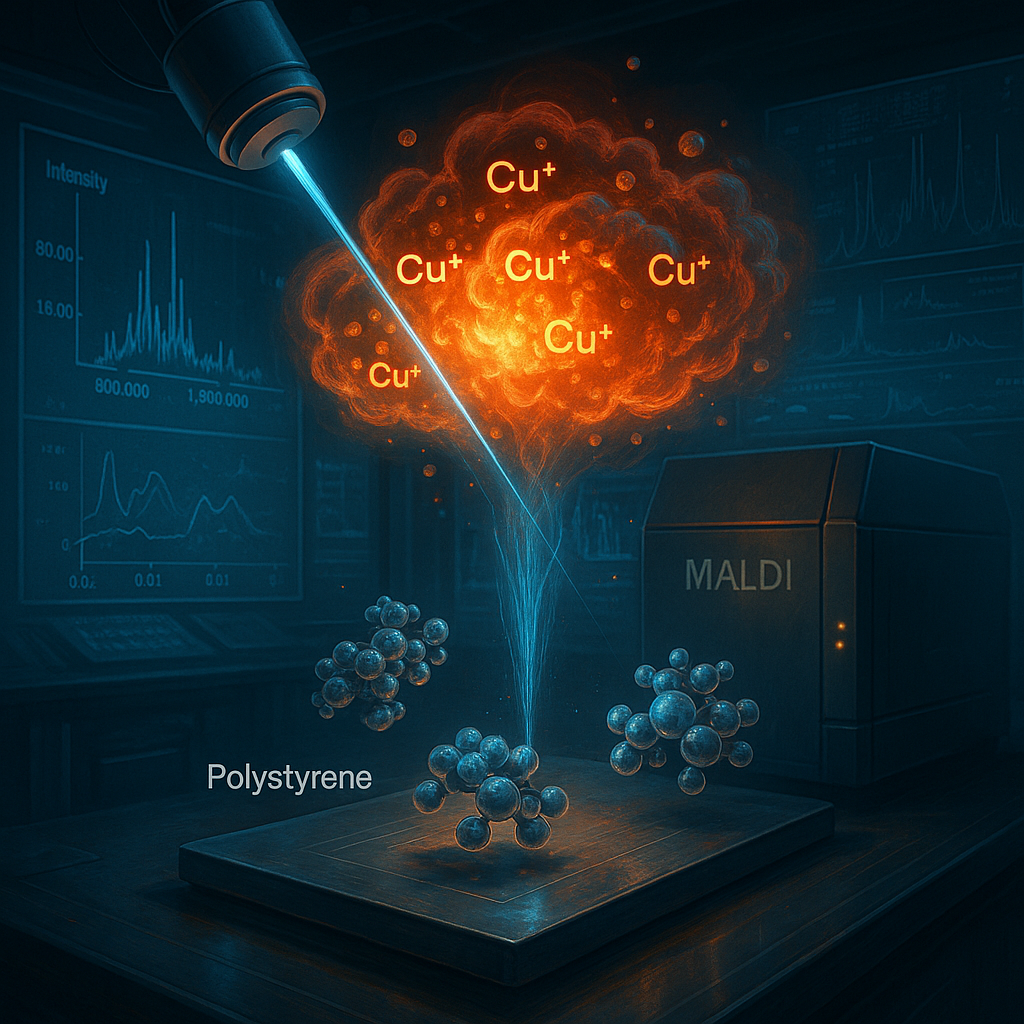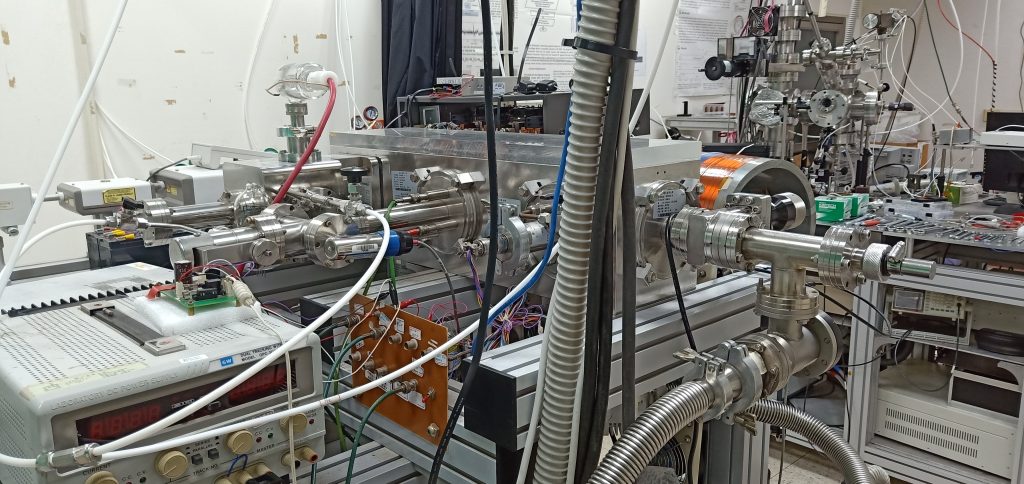In laboratories around the world, scientists have been grappling with a stubborn challenge, i.e., detecting ultra-high molecular weight (UHMW) polymers such as polystyrene with precision. These polymers are ubiquitous in modern materials, from packaging and electronics to biomedical devices. But accurately characterising their massive molecular structures has long posed a technical hurdle.
Now, in a striking advancement, researchers from National Dong Hwa University Taiwan have discovered that replacing traditional silver salts with copper salts in matrix-assisted laser desorption/ionisation mass spectrometry (MALDI-MS) can significantly improve the analysis of these complex substances. This shift could ripple far beyond the confines of laboratory benches, influencing everything from material innovation to environmental monitoring.
This is not merely a story about tweaking a chemical ingredient. It is about rethinking how we observe the synthetic world we’ve built.
The rise of UHMW polymers and the race to understand them
Polymers with ultra-high molecular weight, those that exceed hundreds of thousands or even millions of daltons, are central to many industrial and commercial products. They offer remarkable tensile strength, chemical resistance, and thermal durability. But as useful as they are, their very complexity makes them difficult to analyse.
Mass spectrometry, especially MALDI-MS, has become a preferred tool for polymer characterisation. The technique uses a laser to ionise polymer molecules embedded in a matrix, enabling their mass-to-charge ratios to be measured. However, when it comes to UHMW polystyrene (PS), conventional approaches struggle.
Silver (Ag) and cesium (Cs) salts, commonly used as cationising agents to facilitate ion detection in MALDI-MS, hit an upper detection limit. Beyond approximately 660,000 to 1.1 million daltons, these salts falter. But copper (Cu) salts are changing the game.
Our goal was to break the mass detection ceiling in MALDI-MS, and copper salts gave us that breakthrough. By combining them with our custom LIT-MS system, we not only extended the upper mass limit for polystyrene detection beyond a million Daltons, but also made high-mass polymer analysis more accessible, scalable, and sustainable.
-Dr. Avinash A. Patil, National Dong Hwa University Taiwan
Why copper salts? A shift in analytical chemistry
The recent breakthrough involves using copper salts instead of silver for ionising UHMW PS in MALDI-MS. Under optimised conditions, researchers detected PS with masses reaching up to two million daltons, a record leap.
Unlike silver salts, which tend to produce uncontrollable multiply charged ions, copper salts offer precise charge control. Copper(I) salts can achieve higher charge states of up to +5, while copper(II) salts favour lower states up to +3. This modulation is crucial for precise analysis, as it reduces spectral noise and enhances signal clarity.
Furthermore, copper salts work effectively with both trans-2-[3-(4-tert-butylphenyl)-2-methyl-2-propenylidene]-malononitrile (DCTB) and all-trans-retinoic acid (RA) matrices, although DCTB demonstrates superior performance. This compatibility broadens their application across different sample types and matrices.
The environmental implications: Plastics, pollution and monitoring
Plastics, especially polystyrene, are among the most pervasive pollutants in the modern environment. They resist degradation, accumulate in ecosystems, and pose risks to wildlife and potentially human health.
The ability to detect and quantify UHMW polymers with greater accuracy allows researchers to better understand how these materials behave once released into the environment. How long do they persist? How do they fragment? What is their mass distribution in soil, air, or aquatic systems?
With enhanced MALDI-MS techniques using copper salts, scientists can monitor environmental samples with greater precision. This could lead to better risk assessments and more informed policymaking on plastic waste management and regulation.
Moreover, by identifying previously undetectable fractions of high-molecular-weight polymers in environmental matrices, we may uncover hidden aspects of plastic pollution that have gone unnoticed until now.
A nod to sustainability: Copper’s economic and ecological edge
Cost is another key reason why copper salts are poised to replace silver. Silver is expensive and limited in availability. Copper, in contrast, is abundant, recyclable, and significantly cheaper.
This makes copper not just a scientific improvement, but a sustainable choice. For labs operating with limited budgets, especially in developing countries, this change could democratise high-end polymer analysis. In turn, it supports a more inclusive global research landscape.
Lowering the cost of advanced analytical methods without sacrificing performance is a win for science, education, and the planet.
Reimagining mass spectrometry: The home-built LIT-MS advantage
The breakthrough was realised using a home-built linear ion trap mass spectrometer (LIT-MS), customised to pair with the MALDI technique. Unlike conventional time-of-flight (TOF) MS systems, this setup enhances the ion trapping and detection of high-mass molecules.
Such innovation points to a broader trend in analytical chemistry: tailoring instruments to specific analytical goals. Rather than relying solely on commercial systems, researchers are increasingly building bespoke setups that cater to the unique challenges of their materials.
In this context, the copper salt development not only showcases chemical ingenuity but also represents the next step in instrument evolution. Comparative studies confirm the superiority of copper salts over silver. Not only do copper salts enable higher mass detection, but they also produce cleaner, more controlled ion spectra.
From industry to biomedicine
Beyond environmental monitoring, the improved detection of UHMW polymers has implications for various industries.
In materials science, it supports the design of next-generation plastics with customisable properties. In pharmaceuticals, where polymer-based drug delivery systems are on the rise, accurate characterisation is essential for quality control and regulatory compliance.
In biomedical engineering, UHMW polymers are used in implants and prosthetics. Analysing their structural integrity at a molecular level could improve patient safety and device longevity.
As such, this copper-based technique may soon become a staple across sectors where polymer performance is critical.
A tool for the plastic crisis
Plastic pollution is a defining environmental issue of our time. As policymakers introduce bans, taxes, and recycling targets, there is a growing need for better tools to track plastic materials through their lifecycle.
From production and usage to disposal and degradation, improved MALDI-MS analysis with copper salts offers an evidence-based approach to monitoring these pathways.
It also supports circular economy initiatives by enabling manufacturers to better evaluate recycled content and polymer purity. In a world moving toward sustainable materials management, precision matters.
Closing thoughts: Is copper the new gold standard in polymer analysis?
This innovation straddles chemistry, environmental science, and material engineering. But its true power lies in integration.
For this technique to achieve real-world impact, collaboration is essential. Chemists, environmentalists, toxicologists, industrial designers, and data scientists must work together to build applications around it.
As UHMW polymers continue to evolve in structure and application, so too must our analytical capabilities. Copper salts in MALDI-MS are just one piece of a larger puzzle—but an important one.
The adoption of copper salts for UHMW polymer detection is more than a methodological upgrade, it is a paradigm shift. It improves analytical performance, reduces environmental impact, and lowers costs.
Yet it also raises a bigger question: how many other long-standing scientific practices could be improved with a simple but thoughtful substitution?
In a time when innovation is often equated with complexity, this advancement reminds us that sometimes, the smartest move is a modest change in materials.
Reference
Patil, A. A., Lại, T. K. L., Lee, C. C., Chiu, Y. P., Liu, Z. X., Lin, C. J., & Peng, W. P. (2025). Enhancing mass analysis of ultra-high molecular weight polystyrene: a comparative study of copper and silver salts with MALDI mass spectrometry. Analytical Methods, 17(8), 1754-1764. https://doi.org/10.1039/D4AY02077D








